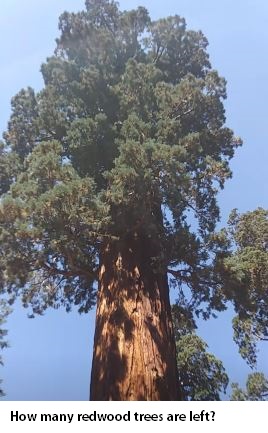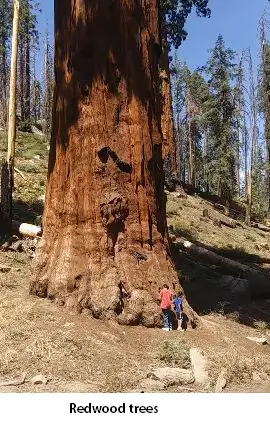Only 5% of redwoods are left today. It’s sad, right? Many ancient redwoods vanished. But, science shows hope. Long ago, huge forests thrived. Now, just a fraction. Logging hurt them badly. But, there’s a plan. More logging, strange as it seems.
Mostly, private lands suffer. Trees, so old, now cut too soon. Just 5% remains. Along the coast, a thin strip. Redwoods, once towering, now few. Science reveals their secrets. They survive, drawing on stored carbon. They adapt, they endure. Recovery, a slow journey. From devastation to growth. Acres lost, just a memory. But some survived. Science shares their tales. In a paper, their resilience. Hope blooms amidst tragedy.
Want to know about redwood trees’ age?

Records show some redwoods live for 2,000 years. On average, they’re 800 to 1,500 years old. Sierra Redwood, world’s oldest trees, fascinating, right? For a 15-feet wide sequoia, it’s 600-2,600 years. Redwoods, especially giant sequoias, ancient and massive. Many are over 2,000 years old. Giant Sequoias reside in Sierra Nevada, 5,000 to 8,000 feet.
They can live up to 3,200 years, towering 311 feet. Their diameters reach up to 40 feet. Common names: coast redwood, coastal redwood, California redwood. Evergreen, they live 1,200–2,200 years or more. Mature forests: trees 500-1,000 years old. Redwoods (Sequoiadendron giganteum), truly giants.
They’ve been around for 240 million years. In California, for over 20 million years. Humans? Only about 200,000 years. Redwoods, some of Earth’s oldest beings. California redwoods can exceed 2,000 years. Giant sequoias, close relatives, equally impressive. Ice ages limited redwood’s range.
Last one ended 10,000 years ago. Redwoods confined to three small regions. The oldest authenticated Coast redwood: 2,200 years. It measured 12 feet in diameter. Fascinating, isn’t it?
Curious about redwood tree height?
These trees can get really tall, like super tall! On average, they’re about 200 to 240 feet high. Some are even taller, reaching 350 feet high! And their trunks can be 10 to 15 feet wide. Imagine that, a tree as wide as a room! The leaves are green, flat, and pointy.
Two-hundred-foot redwoods are very common. Especially near rivers with deep, moist soil. They can grow up to 300 feet tall! And their trunks can be 10 or 11 feet wide. That’s wider than some streets! These trees live a long time, around 2000 years. That’s older than your great-great-great-grandparents! In good conditions, they grow about 2-3 feet each year.
That’s like a little redwood ladder! Coast redwoods live along the Pacific Coast. From California to southern Oregon. Some are so wide, up to 28 feet in diameter! That’s wider than a basketball court!
The tallest one ever recorded was 380 feet tall. That’s like stacking 37 floors on top of each other! So next time you see a redwood, say hello! They’re giants of the forest, reaching for the sky.
Discover the age of mighty redwood trees

They can live over 2,000 years! A redwood forest holds ancient giants, 500-1,000 years old. In one grove, trees stand around 65 years. Coast redwoods last 500-700 years. Some reach over 360 feet tall!
According to Jepson, the oldest known is 3,226 years. Douglas found similar results. They’re called coast redwoods or California redwoods. Evergreen, they live 1,200–2,200 years. Redwoods existed 240 million years. In California, they’ve lived over 20 million years.
Humans, in comparison, 200,000 years. Coast redwoods mature in 400 to 500 years. Some live beyond 1,500 years. Sierra redwoods last up to 3,500 years. Bristlecone pines surpass even them.
Tree age varies widely. These resilient giants live 2,000 to 3,000 years. Find them in Sierra Nevada’s western slope.
Did you know some trees live for thousands of years?
Redwoods, among Earth’s oldest living things, are remarkable. They can grow as tall as 380 feet! ? Coast redwoods, known for their towering height, are ancient. They’ve been around since the time of dinosaurs. These majestic trees embody nature’s beauty over millions of years.
They’re not just tall; they’re strong symbols of endurance. Imagine, some are more than 2,000 years old! Redwood National Park is home to these wonders. It’s not just trees; it’s a sanctuary for diverse life. From indigenous peoples to foreign explorers, it’s history-rich.
Did you know a cockroach might have introduced redwoods to outsiders? Spanish explorers were the first documented visitors to these giants. They marveled at the grandeur of the California redwoods.
Their genome is the second-largest ever sequenced! Redwoods are treasured for their longevity and strength. Some of the oldest living beings grace the North Coast. It’s not just about age; it’s about resilience. It takes centuries for them to reach maturity.
Their diameter can be as wide as 28 feet! Logging poses a threat to these ancient giants. They’re found only in a few corners of the world. But their significance reverberates globally. Sequoioideae, the scientific name for redwoods, tells their story. These trees stand tall as symbols of endurance and beauty. ?
Interested in redwoods Family?
They’re ancient trees with history. They’re from a group of cone-bearing trees long ago. They have a fascinating family tree. Coast redwoods, giant sequoias, and China’s Dawn redwoods.
They share ancestry from ancient times. Dinosaurs once roamed among them. Redwoods and giant sequoias are closely related plants. They belong to the cypress family. Cypress trees are evergreen conifers. Cupressus is one genus in the cypress family. It’s part of Cupressaceae.
This family includes junipers and redwoods. Cupressaceae is a conifer family. It’s known as the cypress family. They’re found worldwide, diverse and plentiful. The cypress family has 27-30 genera. These include junipers and redwoods. There are about 130-140 species in total.
These trees are tall and majestic. Some reach up to 116 meters. They’re monoecious, subdioecious, or rarely dioecious. If you love redwoods, you’ll appreciate their family history. It’s rich with diversity and ancient roots.
Are redwood trees endangered?
Yes, they are at risk. Magnificent redwoods are endangered, need conservation. Listed as “endangered” by conservation organizations. California’s prized redwoods face extinction.
Threatened by logging, habitat loss, climate change. Redwoods vital for ecosystems, including endangered species. Their loss impacts coho salmon, other wildlife, humans. Redwoods not protected by state or federal laws.
It’s crucial we protect them for future generations. Coast redwoods face threats but can be saved. Efforts include replanting, habitat restoration, conservation laws. Let’s preserve these majestic trees for the planet.
How many redwood trees were cut down?
Redwoods, sturdy against bugs, fire, and decay, are valued. Sadly, since the 1850s, 95% of them vanished. From 1890 to 1980, 89% of old growth ones were gone. Did people realize it takes centuries for regrowth? Here’s what I found. According to a report by Carl Betzler, 95% of ancient redwood forests disappeared in just over 100 years! Dr. Seuss was spot on.
Time flew by swiftly indeed. Fun fact: Douglas Firs held the record for tallest trees. But the old-growth ones got axed. The enormity of these redwoods amazed many worldwide. Some were even chopped for exhibitions. Those old-growth redwoods?
They offer unique habitats. Sadly, when cut, this precious habitat vanishes. Between 1900 and 1929, around 520 million board feet of redwoods were cut yearly. Most of it, 80%, came from north of the Golden Gate.
About 80,000 acres of Redwood National and State Parks (RNSP) once held clear-cut forests. Imagine this: Teams used axes and saws to fell these giants. A single tree could take a whole week to topple. So, there you have it. The story of redwoods, once mighty, now mostly memories.
Redwood tree height in meters
Redwood trees reach incredible heights, towering over other species. They stand as giants among all trees, their lofty crowns brushing the sky. Imagine the majesty of a redwood, stretching up to the heavens.
Some soar to a staggering 300 feet in height. Others, like Hyperion, defy belief, piercing the clouds at 380 feet. These arboreal colossi are the pride of nature, awe-inspiring and magnificent.
The Sequoia redwood, with its thick, reddish-brown bark, commands attention. It stands as a testament to time, some living for two millennia. The tallest among them, like Hyperion, are like ancient sentinels guarding the earth. Sequoia National Park in California cradles some of these titans.
Here, the largest redwood stands proudly, towering over its surroundings. Its immense height, 84 meters, rivals that of an eleven-story building. Such grandeur leaves us humbled by nature’s prowess. Redwood trees, the tallest on our planet, embody resilience and strength. They remind us of the enduring beauty and power of the natural world.
Discover Hyperion, tallest known living tree, California, 115.92 meters.
Found in 2006 by Chris Atkins and Michael Taylor. Verified height: 115.55 meters by Stephen Sillett. Hyperion, world’s tallest living tree, stands 379.1 feet high! General Sherman, largest giant redwood, 84 meters tall, California.
Redwood National Park: home to tallest trees, over 380 feet. Hyperion, the tallest living tree, now off-limits to visitors. General Sherman, weighs 2.7 million pounds, stands 275 feet.
Largest redwood in Rockefeller Forest, 10,000 acres! Coast Redwoods reach heights from 300 to 350 feet. Tallest coast redwood, Redwood National Park, nicknamed Hyperion Tree.
Also Read :
